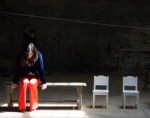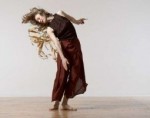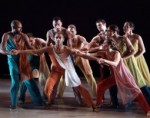
The House of BJM
by Kirsten Kaschock
I have this theory. (I’m a poet, and poets often have theories—a hazard of the trade.) Mine is this: narrative is to poetry as virtuosity is to dance.
Both can get you through the front door.
As a poet, I’ve learned a reader will forgive a writer strange punctuation, odd word use, even a bit of absurdity (markers of “experimentation”)—if the story of the poem is obvious and compelling. Narrative is a universal ticket.
Similarly, audiences of contemporary dance seem capable of moving past conceptual opacity and/or missteps as long as they can rest assured that, physically, the humans onstage are exceptional. If the dancers can do something the audience could never dream of doing, not without risking grave injury, then they may deserve an evening of their time, the money shelled out. In this way, exacting training combined with fortunate genetics can get an audience across the threshold.
I have come to believe that “front door issues” such as story and virtuosity are ignored at an artist’s peril. In the current art market, if you cannot find a way to build an audience, if you cannot articulate your invitation to them, then you will struggle to find purchase (an apt turn of phrase). The poetry I love does not always tell a story, but I do admire a well-told tale-in-verse, just as I admire dance artistry combined with athleticism—for beauty’s sake (yes, I said it) and for the way physical prowess provides a “way in” to a company or a choreographer’s oeuvre. Rigorous training and high levels of execution are guaranteed pleasures. Rather than see them as superficial, I’ve learned to appreciate the time that they take to develop, the funding needed, and the deep commitment required to bring them night after night onto the stage.
There are other ways in, of course. But Les Ballets Jazz de Montréal has this one down: their front door is wide open. It beckons.
Rouge—an ensemble dance choreographed by Rodrigo Pederneiras—also brought, through suggestive costuming and music and intense, stylized dancing, a sense of a theme. The program note calls the piece “a discreet tribute to Native peoples and their musical and cultural legacy.” However, referential subtlety can also be read as vagueness. The percussive chugging, flex-footed passés, rigid torsos, arches skyward, and lateral gestures felt hieroglyphic, two-dimensional—more a throwback to the cultural borrowing of Ted Shawn and Ruth St. Denis than part of a fully articulated 21st century dialogue with First Nations people and their heritage. I ended up wishing the powerful idea of “tribe” had been set in the contentious present or even a dystopian future rather than in some nebulous and romanticized past.
The second piece of the evening, Mono Lisa, partnered Mark Francis Caserta (a University of the Arts graduate) with the ferocious red-maned Céline Cassone. Their sonic backdrop was industrial—the amplified sounds of a typewriter or some other rhythmic machine. For most of the duet, they seemed interlocking parts: his job to lift (and kick), hers to be turned with legs spread wide or en pointe in developé, her recurrent side extension reminiscent of the carriage return lever on my 1916 L. C. Smith swung round at the end of a line or phrase. Itzik Galili’s choreography mined this motif with rigor. By the end of the starkly-lit piece, the couple’s tightly circumscribed maneuvering seemed to reference a certain type of relationship—one in which two volatile humans barely avoid injuring one another, one in which cycling causes exhaustion but never surrender.
Andonis Foniadakis’s Kosmos completed the evening with the company performing explosive crossings, traveling floorwork and exuberant leaps, creating a durational ebb and flow that alluded to the piece’s ambitious title. A few minutes before the curtain dropped, Julien Tarride’s score changed tenor and the dancing slowed. The entire cast moved onstage under lights that fragmented them into a mosaic, an animated frieze of bodies and starlight. The unexpected move from chaotic energy to constellating coalescence brought much of the audience to its feet as the work ended.
Les Ballets Jazz de Montréal ushered me in the front door with the technical skills of its dancers. The stories I was told while inside attest to something deeper—the bones of the house. Although not every room was to my taste, the underlying aesthetic was strong enough to recommend this visitor’s return.
By Kirsten Kaschock
January 24, 2016







